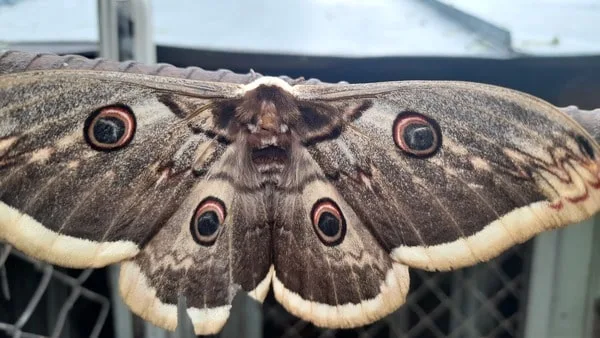A Rare and Wondrous Sight: My Encounter with a Giant Moth, the Largest European Moth
I have always loved butterflies, but I had never seen anything like the giant moth that I encountered in my garden one May morning. It was almost as big as my hand, with a wingspan of over 10 centimeters. I was so excited to see it that I quickly grabbed my phone and took some pictures.
A Remarkable Discovery: The Giant Emperor Moth
The moth was just hanging there, perfectly still. I don't know if it was because it was cold or if it was just curious about me. I stood there for a few minutes, just taking in its beauty. Then, I slowly backed away so as not to disturb it. It stayed there that day for a while and later flew away.
I later learned that the moth was a Giant Emperor Moth, also known as Saturnia pyri. It is the largest moth in Europe, and it is found in a variety of habitats, including forests, gardens, and even urban areas. The moths are active at night, and they feed on nectar from flowers.
I was so lucky to have seen this rare and wondrous creature. It was an amazing experience that I will never forget.
That same kind of moth was seen in our house once before. But that time it came inside the house at night. Read about it here:
Related post: Unexpected visitor - Largest European moth
The Giant Emperor Moth: Saturnia pyri
Saturnia pyri, known as the giant peacock moth, is a Saturniid moth native to Europe. Initially described by Michael Denis and Ignaz Schiffermüller in 1775, this remarkable species has captivated naturalists and enthusiasts alike. Its vibrant coloration, intricate wing design, and size make it an enchanting sight to behold. The distinct "eyes" on its wings serve as a form of mimicry, deterring potential predators and aiding in its survival.
Giant peacock moths are native to Europe, but they can also be found in North Africa and Asia. They prefer to live in warm, wooded areas. The moths are active at night, and they feed on the nectar of flowers. They only live for a few weeks, and their lifespan is usually spent mating and laying eggs.
Superstitious Beliefs: The "Spirit Moth"
In my hometown where the photo of this moth was taken, locals refer to it as a "spirit moth" due to certain superstitious beliefs surrounding its appearance. Some cultures perceive the presence of this majestic creature as a symbol of spiritual significance, associating it with messages from the ethereal realm or indicating an impending change in one's life. While these beliefs may vary, they add an intriguing cultural element to the already awe-inspiring nature of the giant emperor moth.
In some cultures, giant peacock moths are believed to be messengers from the spirit world. They are often seen as a sign of good luck.
Here is the video I took:
What are the distinguishing features of a giant peacock moth?
Giant peacock moths have a wingspan of up to 15-20 cm, making them the largest European moths. They have four "eyes" in their wings, which are actually markings that help to deter predators. They are also brightly colored, with a mixture of green, yellow, and brown.
Where do giant peacock moths live?
Giant peacock moths are native to Europe, but they can also be found in North Africa and Asia. They prefer to live in warm, wooded areas.
Why are giant peacock moths called spirit moths?
A: In some cultures, giant peacock moths are believed to be messengers from the spirit world. They are often seen as a sign of good luck.
Conclusion
I was glad to have the opportunity to see a giant peacock moth up close. It is a truly impressive insect, and I learned a lot about it by doing some research. If you ever have the chance to see one, I encourage you to take a closer look.












